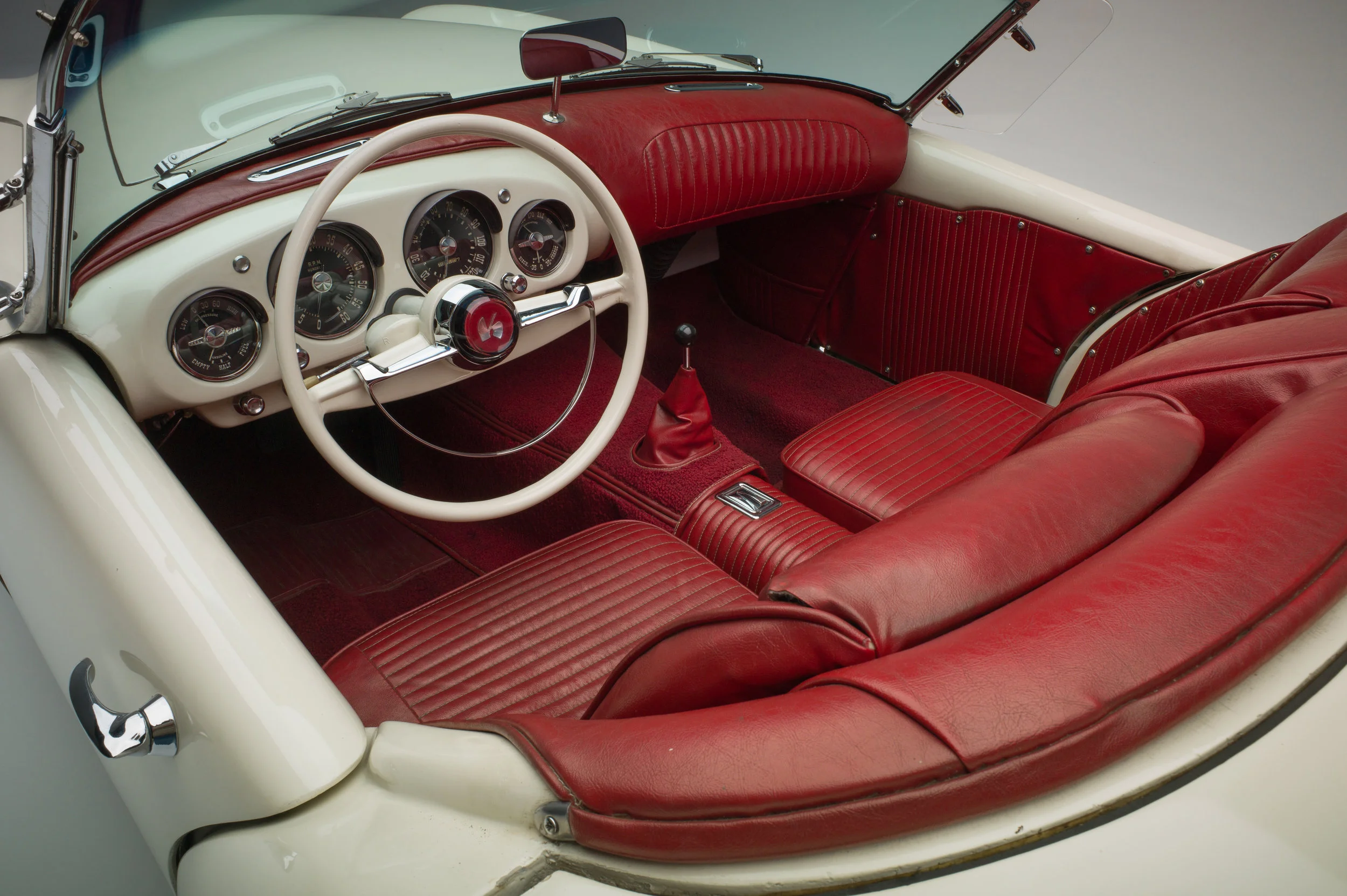1954 Kaiser Darrin






1954 Kaiser Darrin
Post-war America was overflowing with exuberance in the early 1950s, and nowhere was that more evident than in the flock of roadsters appearing on the scene. While the Chevrolet Corvette and Ford Thunderbird receive the lion’s share of attention, both were beaten to market by the agile, unique creation of underdog Kaiser.
- YEAR & MAKE - 1954 Kaiser
- MODEL NAME - Darrin
- SERIES - 161
- MODEL/BODY/STYLE NUMBER - 161
- BODY TYPE - 2 Door, 2 Passenger Roadster
- BODY BY - Fiberglass by Glasspar
- # CYLS. - Strt. 6
- TRANSMISSION TYPE & NUMBER - 3 Speed, Rear-Wheel Drive
- WEIGHT - 2,175 lbs
- ESTIMATED PRODUCTION - #15 of 285
- HP - 90
- C.I.D. - 161
- WHEELBASE - 100″
- PRICE NEW - $3,655
The limited-production 1954 Kaiser Darrin was the first mass-produced fiberglass-bodied car in America, beating the Corvette to market by mere days. Overshadowed by the deeper corporate pockets at Chevrolet, Kaiser’s offering didn’t attract as much attention, despite the car’s significant technical and stylistic advantages.
Designer Howard “Dutch” Darrin was commissioned by Kaiser Motors to overhaul its Henry J compact, turning it into a fun second car for the outgoing American family. Darrin had originally become known for his coachbuilding work with Paris-based Hibbard & Darrin in the 1920s and early 1930s; he later set up shop in Hollywood and produced some of the Packard’s most dramatic bodies of the 1930s and ‘40s. He went to work for Kaiser-Frazer in 1946 as a consultant, quitting shortly thereafter out of frustration when his unconventional designs were repeatedly rejected in favor of safer options. Darrin was still enamored with tK-F’s potential, though, and produced a two-seat roadster concept on his own in the early 1950s. Upon seeing it, Henry J. Kaiser reportedly flew into a fury before being stopped short by his wife, who urged him to consider the car’s marketability. Upon reflection, he agreed that a roadster could find a niche in the marketplace, and green-lighted the development of the car that would become the Kaiser Darrin 161.
Darrin took full advantage of the situation to redo the stodgy little Henry J as a dramatically different kind of car. His signature sweeping, dipped fenderline was unbroken by door hinges; instead, the doors slid on tracks, disappearing into the front fender wells via a patented mechanism. There were no side windows, but a novel three-position top shielded drivers from the elements. The unique, high-positioned grille looked, as one commentator of the period put it, “like it wanted to give you a kiss.”
Color-keyed bucket seats, sports car instrumentation and a floor shifter gave the car a sporty European feel; and amenities such as a thickly padded dashboard and optional seat belts added a hint of luxury.
The choice of fiberglass construction was a critical one. Struggling Kaiser could make molds far more cheaply than it could produce tooling for steel or aluminum bodies, and the lightweight construction meant that the car would have a proportionally better power-to-weight ratio, appropriate for a sports car.
Unfortunately, despite a feathery 2,175-pound curb weight the Darrin’s performance was unable to match its unforgettable style. The Henry J engine wasn’t up to the task of providing gutsy motivation for such a car, and production delays in finding the right powerplant pushed the roadster’s release back significantly. In the end, Kaiser modified a Willys Hurricane 6 engine, adding a high-compression aluminum head, hot camshaft and three-carburetor setup that gave the flathead six a total output of 90hp—hardly remarkable even by the standards of the era. The car’s steep $3,655 price tag and lackluster performance certainly contributed to its poor sales, as did the production delays; only 435 cars were built in its single year. Of those, quite a few remained unsold even when the company was purchased by American Motors in 1955. Dutch Darrin bought as many as he could himself. Outfitted with Cadillac V-8s, Darrin sold them from his Hollywood showroom as Kaiser-Darrin Specials, continuing the legacy and lore of the little fiberglass roadster even beyond the demise of the company that commissioned it.
